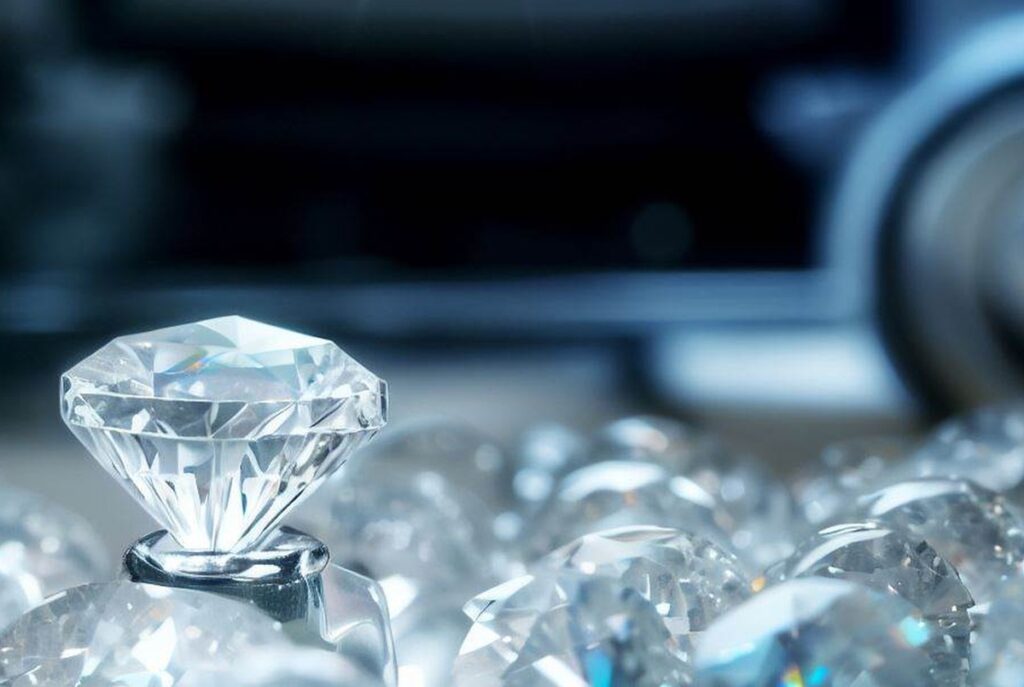Article Contents
Natural diamonds have been a symbol of love and commitment for centuries, with their rarity making them highly prized. But lab-created diamonds are becoming an increasingly popular option, too, so how do you decide between the two? The fight is on – Lab-Created Diamonds Vs Natural Diamonds; which is the winner?
In this article, we’ll look at the differences between natural and lab-created diamonds, giving you all the information you need to decide which is best for your needs. We’ll explore factors such as cost, durability, and ethical considerations to help you make an informed decision. Additionally, we’ll discuss how moissanite compares to natural diamonds in terms of brilliance and sparkle, and how these factors may impact your choice. Whether you’re in the market for an engagement ring or a piece of jewelry, understanding the differences between moissanite vs natural diamond is essential in making the right choice for your preferences and budget.
So let’s dive into the debate – because when it comes to choosing that perfect diamond, everyone deserves to feel like they belong!
Definition And Characteristics
The debate between lab-created diamonds and natural diamonds has been ongoing for years. Both have their own unique characteristics that make them desirable, but which is better?
To understand this question, we must first look at the definition and characteristics of each type of diamond. Lab-created diamonds are formed in a laboratory environment through synthetic production. They are created using carbon sources such as graphite or methane gas. Lab-created diamonds typically exhibit identical aesthetic appeal to natural diamonds, with many featuring clarity grading even better than most earth-mined stones.
The quality of cut can also be quite impressive in lab-created diamonds – that’s because cutting and polishing diamonds is down to the skill and patience of the cutters and polishers who work on both natural and lab-grown diamonds. However, lab-grown diamonds may have a slight edge even in this regard. Natural diamonds in the rough state are usually irregular and often broken down from larger crystals by digging them from the ground.
Lab-grown diamonds are created in a controlled environment and are much more regular and complete, even in their rough form. This might sound like a big deal. However, an important part of the process of creating the diamonds in your jewellery is planning the cut of the diamonds from the rough stone.
The planner must account for flaws in the diamond, must find the most economical way to get finished diamonds from the rough stone and reduce wastage that increases the price of the jewellery we buy. Lab-grown diamonds are more regular and have fewer flaws, meaning the stone’s planning and cutting is easier and more efficient. There is less need to compromise on, for example, symmetry in order to squeeze one more finished diamond from the rough diamond. So, you can expect to have, on average, slightly better cut quality.
These gems possess an unmatched character due to subtle imperfections, otherwise known as “inclusions”, that help give each stone its very own identity. Natural diamonds are graded based on their respective clarity rankings, which helps ensure buyers know exactly what they are getting when purchasing one of these incredible rocks from Mother Nature herself!

Cost Comparison
There are several factors to consider when it comes to the cost comparison of lab-created diamonds vs natural diamonds. Price is usually the first thing people look at, and while lab-created diamonds are often more affordable, they still have comparable quality to natural diamonds. Quality is still important since lab-created diamonds are graded the same as natural diamonds. Durability is also important since the hardness of both diamonds is the same. Clarity is a major factor too, and both lab-created and natural diamonds can have the same clarity and cut.
Rarity is often cited as a major difference. Still, in reality, lab-created diamonds can be made in any size and shape so that they can be just as rare – particularly if the diamond is very large, as these are much more costly and difficult to produce. Confidence is an important factor too, and with lab-created diamonds, you can feel confident knowing exactly where and how it was made.
Regarding ethics, lab-created diamonds are a more sustainable choice since they don’t require digging or mining. Supply and demand are important factors too, and since lab-created diamonds are easier and faster to produce, they can easily meet demand. Resale value is another important factor, and while natural diamonds have a larger resale market, lab-created diamonds can still be worth something. Environmental impact is another factor to consider, and lab-created diamonds have a much lower impact than natural diamonds.
The manufacturing process is also a big factor, and lab-created diamonds are made in a controlled environment, while natural diamonds are mined. Certification is also important since a reputable gemology lab can certify both lab-created and natural diamonds. Lastly, transparency is key; with lab-created diamonds, you can trace the entire process from start to finish.
There are numerous factors to consider when comparing the cost of lab-created diamonds vs natural diamonds. Although price is typically the first consideration, lab-created diamonds are often less expensive while still maintaining comparable quality to natural diamonds.
Quality
When it comes to quality, lab-created diamonds are just as reliable and secure as their natural counterparts. They go through the same rigorous gem grading process, use the same supply chain production methods, and follow the same responsible mining practices that guarantee a diamond’s authenticity.
Moreover, they provide an ethical alternative by completely avoiding any potential human rights violations associated with traditional diamond mining operations. So not only do you get peace of mind when purchasing your jewellery piece and assurance that no unethical processes were involved in its creation – giving customers a stronger sense of belonging to something authentic and meaningful.




Durability
Regarding durability, natural and lab-created diamonds have the same explosion resistance, scratch hardness, and heat conduction capabilities. This means that you won’t need to worry about compromising on quality if you decide to go with a lab-created diamond; they are just as resilient in terms of their physical properties.
Furthermore, their superior production methods make these diamonds more consistent in quality than those found naturally – providing customers with an extra layer of peace of mind when investing in such a precious item. Some natural diamonds may have internal flaws that weaken the structure of the diamond; this is not an issue with lab-created diamonds. Lab-grown diamonds also have a smaller environmental impact, as they require fewer resources and do not involve destructive mining practices. Additionally, lab-grown diamonds are often less expensive than their natural counterparts, making them an attractive option for budget-conscious consumers. In conclusion, when comparing labgrown diamonds vs natural diamonds, it is clear that lab-grown diamonds offer a more sustainable, affordable, and reliable alternative to traditional diamonds.
So no matter what type of diamond you purchase for your jewellery piece, it will be able to withstand any test you put it through and always look beautiful – giving wearers a sense of appreciation for something so meaningful and timeless.
Clarity
Once you’ve decided between natural and lab-created diamonds based on their physical properties, it’s time to discuss clarity.
Clarity has a large impact when comparing costs as it is determined by how many inclusions are present inside each diamond.
Natural diamonds tend to have more imperfections than their lab-created counterparts, which can make them less expensive but also decrease their perceived value – especially for those looking for a symbol of marriage or another special occasion.
Ultimately, however, it comes down to personal preference; what matters most is finding something that speaks to your individual taste and style rather than focusing solely on price point.
It should also be noted that legally speaking, all diamonds must meet certain standards regardless of their origin, so there shouldn’t be any concern about quality when making such an important purchase.
With that being said, shopping for jewellery is ultimately about finding something meaningful and unique – and with either option, you’ll be able to find just that!
Environmental Impact
Let’s explore the environmental footprints and carbon emissions of lab-created diamonds and natural diamonds. We’ll compare how each type of diamond impacts the environment, so you can make an informed decision when selecting your jewellery.
Environmental Footprint
When it comes to diamonds, many consumers are looking for a way to feel connected to the Earth without harming our planet. With that said, one of the most important considerations when selecting a diamond should be its environmental impact.
Natural diamonds often have a greater environmental footprint due to their mining and excavation processes—not to mention their potential connection with unethical practices in conflict-affected areas. On the other hand, lab-created diamonds offer an ethical alternative with sustainable sourcing and modern manufacturing processes. The result is an eco-friendly option that allows you to make conscious choices about where your jewellery purchase will come from.
In short, if you’re looking for a more responsible choice for your next diamond purchase, look no further than lab-created diamonds: a beautiful and guilt-free way to express yourself!
Carbon Emissions
Making a conscious decision to reduce your carbon footprint is an important consideration when it comes to diamonds.
Natural diamonds may have a higher economic footprint due to their mining and excavation processes. In contrast, lab-created diamonds are created using sustainable production methods which don’t involve any health risks.
Lab-created diamonds provide the perfect way for you to express yourself without worrying about impacting our planet’s environment.
With so many options available, there’s no reason why you can’t find the diamond that reflects who you are as well as your commitment to protecting our planet!
Durability
When comparing lab-created diamonds to natural ones, durability is an important factor.
Natural diamonds are formed over millions of years in the depths of Earth’s crust and have superior strength due to their embedded mining process.
On the other hand, lab-created diamonds require less energy for production and don’t carry the same carbon footprint as mined diamonds.
However, this does not mean that lab-created diamonds lack quality or brilliance; these stones must pass through a rigorous grading system before being certified by appraisal methods such as the Gemological Institute of America (GIA).
Synthetic production ensures that all lab-created diamonds come out flawless and identical in size and shape.
Since they are made using advanced technology and cutting-edge techniques, lab-created diamonds are expected to last a lifetime without any significant damage or discolouration when handled with care.
As they both possess unique qualities, depending upon your preference, you may decide which type of diamond suits best for you based on individual factors such as budget, lifestyle, etc.
Ethical Considerations
When considering the ethical implications of lab-created diamonds versus natural diamonds, there are plenty of aspects to take into account.
Conflict resolution, labour conditions, consumer perception, and ethical supply chain practices must be considered when sourcing diamond materials. It’s important to ensure that all stakeholders involved in the process are treated fairly and ethically – from mine workers to suppliers.
It’s also essential for jewellers to clearly understand where their diamonds come from, so they can guarantee transparency throughout the entire production journey.
Consumers should also be educated on what goes into producing each type of diamond so they can decide which one is best suited for them. This could mean being aware of either choice’s environmental or social impacts.
As we progress, it will become increasingly important for jewellers to reassess their own practices around sourcing diamonds and assess how they align with modern consumer expectations.
With this knowledge comes an opportunity to create meaningful solutions that address current issues within the industry while delivering quality products that meet customer needs.
Are Lab-Grown Diamonds a Better Alternative to Natural Diamonds?
Labgrown diamonds are an innovative choice that mirrors the brilliance of natural diamonds while being more sustainable and affordable. These gemstones are created in controlled environments, eliminating the environmental and ethical concerns tied to mining. With identical chemical structures, labgrown diamonds offer a guilt-free and modern alternative for conscious shoppers seeking impeccable beauty.
Conclusion
In conclusion, the bout between lab-created vs natural diamonds largely comes down to personal preference.
Lab-created diamonds are an excellent choice for those looking for a cost-effective option without compromising on quality. They offer many of the same characteristics as their natural counterparts while leaving less of an environmental impact in their wake.
In terms of durability, both gems will last a lifetime if properly taken care of.
Lastly, there are also ethical considerations when it comes to mining operations which can be avoided by going with a lab-created diamond instead.
Ultimately, I believe that whichever gem you choose should reflect your own style and values – whether it’s a lab-created or natural diamond.
Take the time to explore and research both lab-created and natural diamonds before making a decision. Choose the gem that aligns with your personal style and values. Remember, both options can be stunning and ethical choices. So, don’t hesitate to make a choice that makes you feel confident and proud!

